Magnetostatics
Magnetostatics is a branch of physics focused on the behavior of magnetic fields produced by steady (non-varying) electric currents. Unlike dynamic systems where fields change with time, magnetostatics considers static conditions, offering a simplified yet powerful framework for understanding how magnetic forces influence materials and space. It is one of the fundamental pillars in the study of electricity & magnetism and provides foundational knowledge essential for both theoretical and applied sciences.
To appreciate the principles of magnetostatics, it helps to start with a solid grounding in physics and basic electrical circuits. These introduce how current flows and sets the stage for understanding the magnetic fields they generate. From here, students transition to the more complex dynamics explored in electrodynamics, but magnetostatics focuses solely on unchanging conditions.
The distinction between time-varying and static fields becomes clearer when comparing magnetostatics with electromagnetic induction or electromagnetic waves, both of which involve dynamic interplay. In contrast, magnetostatics enables precise modeling of magnetic fields from sources such as permanent magnets or direct currents in conductors.
Related domains like electrostatics deal with static electric charges and help build symmetry in understanding field behavior. A study of magnetic fields is crucial, as magnetostatics delves into how these fields are formed, structured, and mathematically described through laws like Biot–Savart and Ampère’s Law.
In advanced topics such as magnetohydrodynamics (MHD) or plasma physics, magnetostatics serves as a foundation for exploring interactions between magnetic fields and fluids or ionized gases. These applications become even more fascinating when viewed through the lens of quantum electrodynamics (QED), where field quantization and particle interactions come into play.
The unusual behaviors in materials like superconductors are explored in superconductivity, where magnetostatics helps describe magnetic flux exclusion and levitation effects. Beyond direct applications, students may also find links to light and optics, where magnetic phenomena impact wave propagation in certain media.
Innovations in laser optics and fiber optic technologies often exploit magneto-optic effects, making a basic understanding of magnetostatics essential. Studies in atmospheric and environmental optics and bio-optics may also incorporate magnetically influenced light behavior.
The principles of geometrical optics, nonlinear optics, and quantum optics provide valuable analogies for understanding wave and field interactions. Similarly, photonics, visual optics, and wave optics often reveal cross-disciplinary methods of analyzing and detecting magnetic effects in optical systems.
Finally, the broader context provided by modern physics allows students to see how magnetostatics, though seemingly simple and classical, forms the foundation for exploring quantum phenomena and advanced technologies. Through this integrated view, magnetostatics becomes not just a static theory but a dynamic gateway to understanding magnetic forces in nature and engineered systems.
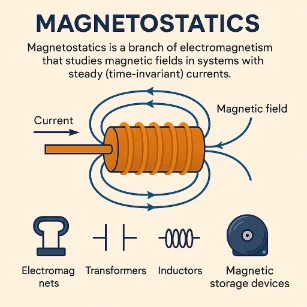
Table of Contents
Basic Concepts of Magnetostatics
Magnetic Field (𝐁⃗)
A magnetic field represents the magnetic influence produced by moving charges (currents) or magnetic materials. It is a vector field, meaning it has both magnitude and direction at every point in space.The magnetic field is measured in Tesla (T) in the SI system.Magnetic Force (Lorentz Force)
A moving charge in a magnetic field experiences a force called the Lorentz force, given by:𝐅⃗ = q (𝐯⃗ × 𝐁⃗)
Where:- q: Charge of the particle
- 𝐯⃗: Velocity vector of the particle
- 𝐁⃗: Magnetic field vector
𝐅⃗ = I (𝐋⃗ × 𝐁⃗)
Where:- I: Current in the wire
- 𝐋⃗: Length vector of the conductor in the direction of current
- 𝐁⃗: Magnetic field vector
Fundamental Laws of Magnetostatics
1. Biot-Savart Law
The Biot-Savart Law gives the magnetic field generated by a small segment of current-carrying wire:Magnetic Field Generated by a Small Segment of Current-Carrying Wire = (permeability of free space)(current)(small segment of the conductor)X(unit vector from the current element to the observation point)/{(4
Applications:- Calculating magnetic fields from wires, loops, and solenoids.
2. Ampère’s Circuital Law
Ampère’s Law relates the integrated magnetic field around a closed loop to the current passing through that loop:integrated magnetic field around a closed loop to the current passing through that loop = (permeability of free space)(net current enclosed by the loop)
Applications:- Used for symmetric current distributions like solenoids and toroids.
3. Gauss’s Law for Magnetism
This law states that magnetic field lines are continuous and have no beginning or end, implying that there are no magnetic monopoles:Or, in integral form:Interpretation: The net magnetic flux through any closed surface is zero.Magnetic Field of Common Configurations
1. Magnetic Field Due to a Long Straight Wire
Using Ampère’s Law, the magnetic field at a distance r from a long, straight current-carrying wire is:The magnetic field forms concentric circles around the wire.Magnetic Field at a Distance r from a Long, Straight Current-carrying Wire = (permeability of free space)(current)/{2
2. Magnetic Field of a Circular Current Loop
The magnetic field at the center of a circular loop of radius R carrying current I is:3. Magnetic Field of a Solenoid
A solenoid is a coil of wire. The magnetic field inside a long solenoid is uniform and given by: Magnetic Field inside a Long Solenoid = (permeability of free space)(total number of turns)(current)4. Magnetic Field of a Toroid
A toroid is a coil wound into a circular ring. The magnetic field inside a toroid is:Magnetic Field inside a Toroid = (permeability of free space)(total number of turns)(current)/{2
Magnetic Materials
Diamagnetic Materials
- Weakly repelled by a magnetic field.
- No permanent magnetic moment.
- Examples: Copper, Silver, Bismuth.
Paramagnetic Materials
- Weakly attracted to magnetic fields.
- Magnetic moments align partially with the external field.
- Examples: Aluminum, Platinum.
Ferromagnetic Materials
- Strongly attracted to magnetic fields.
- Permanent magnetic moments that align with external fields.
- Examples: Iron, Nickel, Cobalt.
Applications of Magnetostatics
1. Electromagnets
Used in devices like relays, motors, and magnetic locks, where the magnetic field is generated by steady currents.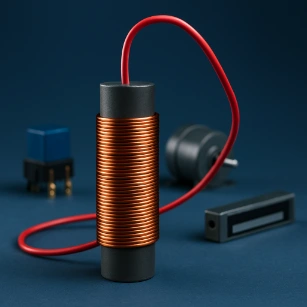
2. Magnetic Storage Devices
Hard drives and magnetic tapes rely on magnetostatic principles to store information.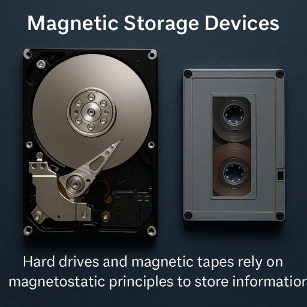
3. MRI Machines
Magnetostatics is foundational in generating the strong, uniform magnetic fields needed in Magnetic Resonance Imaging (MRI).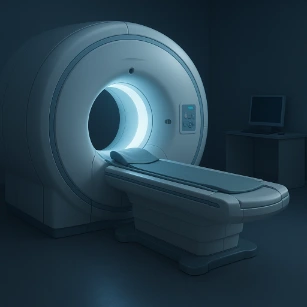
4. Transformers and Inductors
These devices use steady magnetic fields to transfer energy between circuits.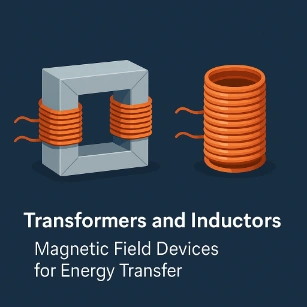
Magnetostatics Numerical Examples
Example 1: Magnetic Field Near a Wire
Problem: Find the magnetic field 2 cm away from a long straight wire carrying 5 A.Solution: Answer: The magnetic field isExample 2: Magnetic Field at the Center of a Loop
Problem: A circular loop of radius 0.1 m carries 3 A. Find the magnetic field at its center.Solution: Answer: The magnetic field isExample 3: Magnetic Field Inside a Solenoid
Problem: A solenoid has 500 turns/m and carries a current of 2 A. Find the magnetic field inside.Solution: Answer: The magnetic field isWhy Study Magnetostatics
Exploring Steady-State Magnetic Fields
Magnetostatics involves the study of magnetic fields in systems with constant currents and unchanging configurations. Students examine the behavior of magnetic fields around steady current-carrying wires, loops, and solenoids. This subject provides a foundational understanding of how magnetic fields behave in static conditions, which is crucial for analyzing more complex dynamic systems. A solid grasp of magnetostatics builds the necessary intuition and analytical skills for tackling full electrodynamic theory.
Mathematical Formulation and Vector Fields
Students learn to apply Biot–Savart Law and Ampère’s Law to calculate magnetic fields in symmetrical configurations. These tools require the use of vector calculus, enabling students to develop proficiency in analytical methods that are applicable across many areas of physics. Magnetostatics reinforces concepts like divergence-free fields and boundary conditions, which are critical in field theory and electromagnetism. The rigorous mathematical approach enhances problem-solving capabilities and deepens physical insight.
Applications in Engineering and Technology
Magnetostatic principles are used extensively in the design of electromagnets, magnetic shielding, and magnetic storage devices. Students analyze how magnetic materials behave in various field configurations, gaining knowledge that supports innovation in sensors, transformers, and inductors. Understanding how static fields influence materials and devices helps students contribute to developments in electric machinery and medical imaging. This knowledge provides a strong bridge to real-world applications in energy, computing, and transportation.
Visualization and Physical Interpretation
By mapping magnetic field lines and examining their geometry, students learn to interpret complex field interactions intuitively. This visual component aids in understanding the directionality and interaction of fields, especially when extended to multipole expansions or boundary value problems. Visualization techniques also enhance comprehension of how magnetic materials respond to external fields. These skills are essential for building accurate mental models of physical systems.
Gateway to Advanced Electromagnetism
A firm understanding of magnetostatics is necessary before progressing to the full formulation of Maxwell’s equations and time-varying fields. Students who master this topic are well prepared for courses in electrodynamics, plasma physics, and electromagnetic wave propagation. The conceptual clarity gained here helps in theoretical derivations as well as computational modeling. It lays the groundwork for both academic research and applied technological innovation.
Conclusion
Magnetostatics provides a deep understanding of magnetic fields produced by steady currents. It explains magnetic interactions in simple systems like wires and coils and complex devices like transformers and inductors. With applications in electronics, medical imaging, and data storage, magnetostatics is foundational in both theoretical and applied physics.Review Questions and Answers:
1. What is magnetostatics?
Answer: Magnetostatics is the branch of electromagnetism that studies magnetic fields in systems where the currents are steady (time-independent) and the magnetic fields do not change with time.
2. How is Gauss’s law for magnetism stated, and what does it imply about magnetic monopoles?
Answer: Gauss’s law for magnetism states that the net magnetic flux through any closed surface is zero, implying that magnetic monopoles do not exist and magnetic field lines form closed loops.
3. What are the primary sources of magnetic fields in magnetostatics?
Answer: The primary sources are steady electric currents (such as those in wires, coils, and solenoids) and permanent magnets, which have intrinsic magnetic moments due to electron spin and orbital motion.
4. How does the right-hand rule help in determining the direction of the magnetic field around a current-carrying conductor?
Answer: By pointing your thumb in the direction of the conventional current, your curled fingers indicate the circular direction of the magnetic field lines encircling the conductor.
5. What is the significance of the magnetic dipole moment in magnetostatics?
Answer: The magnetic dipole moment quantifies the strength and orientation of a magnet or current loop. It determines the torque a magnetic dipole experiences in an external magnetic field and is key to understanding magnetic interactions.
6. How do you calculate the magnetic field produced by a long, straight current-carrying wire?
Answer: The magnetic field at a distance r from a long, straight wire carrying current I is given by B=2πrμ0I, where μ0 is the permeability of free space.
7. What role do permanent magnets play in magnetostatics?
Answer: Permanent magnets generate a steady magnetic field due to the alignment of magnetic domains within the material, and their fields can interact with currents and other magnets in various applications.
8. How does the concept of superposition apply to magnetic fields?
Answer: The principle of superposition states that the net magnetic field at any point is the vector sum of the magnetic fields produced by each individual source, allowing complex field configurations to be analyzed by summing simpler fields.
9. What is the relationship between the magnetic vector potential and the magnetic field?
Answer: The magnetic field is the curl of the magnetic vector potential (B=∇×A), a concept that simplifies solving for the field in complex geometries and is useful in advanced theoretical treatments.
10. How are magnetic fields used in practical applications such as MRI and magnetic storage?
Answer: In MRI, strong, uniform magnetic fields align the nuclear spins of atoms in the body, while gradients and radiofrequency pulses provide imaging data. In magnetic storage, data is encoded by altering the magnetic orientation of small regions in a material.
Thought-Provoking Questions and Answers:
1. How does the absence of magnetic monopoles, as implied by Gauss’s law for magnetism, influence our understanding of magnetic field lines?
Answer: Without magnetic monopoles, magnetic field lines always form closed loops, meaning that every field line that exits a magnet’s north pole must eventually enter its south pole. This symmetry shapes our theoretical models and differentiates magnetism fundamentally from electrostatics, where isolated charges can exist.
2. In what ways can computational modeling enhance the analysis of complex magnetic field distributions in engineered devices?
Answer: Computational modeling, such as finite element analysis, enables precise simulation of magnetic field distributions in complex geometries. It helps optimize device designs, predict performance under varying conditions, and reduce the need for extensive prototyping, ultimately accelerating technological innovation.
3. How might novel magnetic materials, such as metamaterials, revolutionize the control of static magnetic fields?
Answer: Metamaterials can be engineered to exhibit unconventional magnetic properties, like negative permeability or tailored anisotropy. These properties can be used to focus or redirect magnetic fields in ways that conventional materials cannot, opening up new possibilities for high-efficiency transformers, cloaking devices, and advanced sensors.
4. How can the principle of superposition be applied to design magnetic shielding in sensitive electronic equipment?
Answer: By understanding that the net magnetic field is the sum of individual fields, engineers can design multi-layered shields that cancel unwanted external magnetic fields. Optimizing the placement and materials of these layers ensures that sensitive components remain unaffected by interference.
5. What are the challenges in measuring weak magnetic fields in the presence of strong ambient fields, and how can they be overcome?
Answer: Measuring weak magnetic fields requires high sensitivity and noise reduction. Techniques such as using SQUIDs (superconducting quantum interference devices), differential measurements, and advanced filtering algorithms help isolate and accurately measure weak signals amid stronger ambient fields.
6. How does the orientation of magnetic domains within a material affect its macroscopic magnetic properties?
Answer: The alignment of magnetic domains determines whether a material exhibits strong permanent magnetism or behaves as a soft magnetic material. Understanding and controlling domain orientation through treatments like annealing can tailor materials for specific applications, from data storage to electric motors.
7. What potential applications might arise from a deeper understanding of the magnetic vector potential in complex systems?
Answer: The magnetic vector potential simplifies calculations in regions with complicated magnetic fields. Advances in its application could lead to improved designs in electromagnetics, such as more efficient antenna systems, novel magnetic sensors, and enhanced computational techniques in quantum electrodynamics.
8. How do magnetic fields interact with superconductors, and what are the implications for future energy technologies?
Answer: Superconductors expel magnetic fields through the Meissner effect and can carry large currents with zero resistance. These properties are exploited in technologies like MRI magnets and maglev trains, and they hold promise for lossless power transmission and high-field magnets in fusion reactors.
9. In what ways can the study of magnetostatics inform our understanding of planetary magnetic fields and space weather?
Answer: Planetary magnetic fields, generated by dynamo processes in a planet’s core, are analyzed using magnetostatic principles. Understanding these fields helps predict space weather, protect satellites from solar storms, and even provide insights into the internal structure and evolution of planets.
10. How might advancements in measurement techniques impact the future study of static magnetic fields in biological systems?
Answer: Improved sensors and imaging techniques can provide detailed maps of magnetic fields in biological tissues, enhancing our understanding of phenomena such as neural activity and magnetoreception in animals. This research could lead to breakthroughs in medical diagnostics and treatments.
11. What are the implications of static magnetic field manipulation for data storage technologies?
Answer: Manipulating static magnetic fields at microscopic scales enables the precise control of magnetic domains in storage media. Innovations in this area can lead to higher data densities, faster read/write speeds, and more durable memory devices, significantly advancing information technology.
12. How can interdisciplinary research between magnetostatics and materials science lead to the development of next-generation electronic devices?
Answer: Combining magnetostatic principles with materials science allows for the creation of advanced magnetic materials and composites. These interdisciplinary efforts can result in devices with improved performance, reduced energy consumption, and novel functionalities, such as spintronic components that leverage electron spin for data processing.
Numerical Problems and Solutions:
1. A long, straight conductor carries a current of 10 A. Calculate the magnetic field at a distance of 0.05 m from the wire. (Use μ₀ = 4π×10⁻⁷ T·m/A)
Solution:
.
2. Two parallel wires 0.02 m apart carry currents of 8 A each in the same direction. Find the force per unit length between them.
Solution:
.
3. A circular loop with a radius of 0.10 m has 30 turns. If it is placed in a uniform magnetic field of 0.3 T, calculate the magnetic flux through the loop.
Solution:
Area per loop: .
Magnetic flux per loop: .
Total flux for 30 turns:
4. A rectangular loop of dimensions 0.15 m by 0.10 m is placed in a magnetic field of 0.4 T. Calculate the flux through the loop if it is perpendicular to the field.
Solution:
Area, .
Flux, .
5. A solenoid has 1000 turns and a length of 0.8 m. If it carries a current of 3 A, calculate the magnetic field inside the solenoid.
Solution:
Turns per unit length, .
.
6. A permanent magnet creates a magnetic field of 0.2 T at a distance of 0.05 m. If the field strength follows an inverse cube law with distance, estimate the field at 0.10 m.
Solution:
For an inverse cube law: B∝r31.
.
7. A bar magnet has a magnetic dipole moment of 0.8 A·m². Calculate the magnetic field at a point along the axial line at a distance of 0.2 m from the magnet’s center.
Solution:
Magnetic field along the axial line: .
.
8. A cylindrical conductor of radius 0.02 m carries a current of 6 A uniformly. Calculate the magnetic field at a point 0.01 m from the center (inside the conductor).
Solution:
For r<R: .
.
9. A square loop with side length 0.10 m and 1 turn is placed in a uniform magnetic field of 0.5 T. If the loop is rotated by 90° from perpendicular to parallel with the field in 0.4 s, calculate the induced EMF.
Solution:
Initial flux,
Final flux, .
.
.
10. A solenoid with 500 turns, a cross-sectional area of 0.001 m², and a length of 0.5 m is subject to an external magnetic field that increases from 0.1 T to 0.4 T in 1.0 s. Calculate the induced EMF in the solenoid.
Solution:
Change in magnetic field, .
Flux per turn change, .
Total flux change,
.
11. A magnetic dipole moment of 1.2 A·m² is aligned with a uniform magnetic field of 0.25 T. Calculate the potential energy of the dipole in the field.
Solution:
Potential energy, .
For alignment, , so .
12. Two identical bar magnets, each with a magnetic dipole moment of 0.5 A·m², are aligned end-to-end along their axial line and separated by 0.1 m. Estimate the magnitude of the magnetic field at the midpoint between them due to one magnet.
Solution:
Using the formula for the axial field of a dipole:
with A·m² and (half of 0.1 m).
.
For two magnets aligned similarly, the net field at the midpoint would be the vector sum; however, if they are identical and oppositely oriented, the fields might partially cancel depending on their arrangement.
